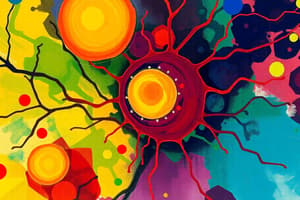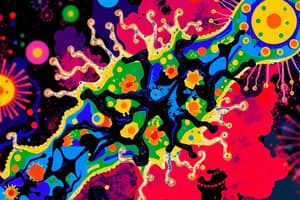Podcast
Questions and Answers
What is a systemic effect of proinflammatory cytokines?
What is a systemic effect of proinflammatory cytokines?
- Enhanced tissue perfusion
- Fever from hypothalamic action (correct)
- Reduced white blood cell production
- Increased vascular permeability
What is a potential consequence of systemic TNF during inflammation?
What is a potential consequence of systemic TNF during inflammation?
- Increased production of anti-inflammatory cytokines
- Decreased cardiac function (correct)
- Enhanced healing of tissue
- Improvement in metabolic activity
What role does IL-8 play in acute inflammation?
What role does IL-8 play in acute inflammation?
- Recruit neutrophils to the infection site (correct)
- Increase production of antibodies
- Promote tissue repair
- Inhibit leukocyte migration
Which of the following describes a harmful effect of acute inflammation?
Which of the following describes a harmful effect of acute inflammation?
What occurs when acute inflammation fails to resolve?
What occurs when acute inflammation fails to resolve?
What is the primary role of the complement system upon activation?
What is the primary role of the complement system upon activation?
Which process describes the coating of a microorganism to make it more susceptible to phagocytosis?
Which process describes the coating of a microorganism to make it more susceptible to phagocytosis?
Which of the following is NOT a function of cytokines?
Which of the following is NOT a function of cytokines?
What term describes cytokines that can act on various cell types?
What term describes cytokines that can act on various cell types?
Which cytokine is NOT mentioned as an example in the context provided?
Which cytokine is NOT mentioned as an example in the context provided?
What is the nature of the signals generated by cytokines?
What is the nature of the signals generated by cytokines?
Which feature indicates that multiple cytokines can perform similar functions?
Which feature indicates that multiple cytokines can perform similar functions?
Which of the following best describes the complement proteins before activation?
Which of the following best describes the complement proteins before activation?
Which cells perform extracellular killing in the innate immune response?
Which cells perform extracellular killing in the innate immune response?
What determines the activation of NK cells?
What determines the activation of NK cells?
What do NK cells release to induce cell death in the target cells?
What do NK cells release to induce cell death in the target cells?
Which molecules do NK cells recognize to identify unhealthy cells?
Which molecules do NK cells recognize to identify unhealthy cells?
What role do Class I MHC molecules play in protecting healthy cells from NK cells?
What role do Class I MHC molecules play in protecting healthy cells from NK cells?
What can cause NK cells to activate and eliminate a target cell?
What can cause NK cells to activate and eliminate a target cell?
What type of proteins do NK cells secrete to enhance the immune response?
What type of proteins do NK cells secrete to enhance the immune response?
Which of the following is NOT a component of innate immunity?
Which of the following is NOT a component of innate immunity?
Which of the following accurately describes the properties of cytokines?
Which of the following accurately describes the properties of cytokines?
What is the primary role of Type I Interferons in the antiviral immune response?
What is the primary role of Type I Interferons in the antiviral immune response?
Which cytokines are known as pro-inflammatory and produced during the acute inflammatory response?
Which cytokines are known as pro-inflammatory and produced during the acute inflammatory response?
What triggers the liver to produce acute-phase proteins?
What triggers the liver to produce acute-phase proteins?
What is one of the major events in the inflammatory response?
What is one of the major events in the inflammatory response?
Which of the following can enhance phagocytosis and stimulate complement activation?
Which of the following can enhance phagocytosis and stimulate complement activation?
What is the function of Type II Interferons?
What is the function of Type II Interferons?
What consequence does increased capillary permeability have during inflammation?
What consequence does increased capillary permeability have during inflammation?
Flashcards are hidden until you start studying
Study Notes
Innate Immunity
- Innate immunity is a non-specific defense mechanism that provides an immediate response to pathogens
- Comprises mechanical and chemical barriers, phagocytic cells, circulating effector proteins, and inflammation
Mechanical and Chemical Barriers
- Physical barriers such as skin and mucous membranes prevent pathogen entry
- Chemical barriers include secretions like saliva, tears, and gastric acid, containing antimicrobial compounds
- Normal bacterial flora competes with pathogens for nutrients and space, hindering their growth
Phagocytosis
- Phagocytic cells like neutrophils, macrophages, and dendritic cells engulf and destroy pathogens
- Steps of phagocytosis:
- Chemotaxis: Phagocytes are attracted to the site of infection
- Adherence: Phagocytes bind to pathogen surface
- Ingestion: Phagocyte engulfs the pathogen, forming a phagosome
- Digestion: Phagosome fuses with lysosomes, containing enzymes that break down the pathogen
Extracellular Killing
- Natural killer (NK) cells eliminate large particles that cannot be phagocytosed, such as virus-infected cells and cancer cells
- NK cells express surface markers CD16 and CD56 and perform extracellular killing as part of innate immunity
- NK cell activation is determined by a balance between activating and inhibitory receptors
- Activating receptors recognize stress molecules on infected or cancerous cells, while inhibitory receptors recognize self-MHC class I molecules on healthy cells
Circulating Effector Proteins
-
Complement System:
- A group of soluble plasma proteins circulating in an inactive form
- Activated by microbial surfaces or antibody-antigen complexes
- Effects:
- Inflammation: Degranulation of mast cells and basophils leading to increased vascular permeability and phagocyte recruitment
- Opsonization: Enhancing phagocytosis by coating pathogens with complement components
- Direct lysis of bacteria
-
Cytokines:
- Small regulatory proteins that are produced in response to microbes and other antigens
- Facilitate communication between cells to trigger immune responses
- Involved in various aspects of innate and adaptive immunity, including inflammation and cell growth and differentiation
- Examples: Interleukin 1, IL-6, TNF-α, and interferons
- Act on target cells through autocrine, paracrine, and endocrine pathways
-
Acute Phase Proteins:
- Released by the liver in response to cytokines from activated immune cells
- Examples: C-reactive protein and mannose-binding proteins
- Enhance phagocytosis (opsonins) and stimulate complement activation
Inflammation
-
An innate immune reaction concentrating immune cells and products at the site of infection or tissue damage
-
Aims to eradicate infectious agents and promote tissue repair.
-
Major events:
- Vasodilation: Increases blood supply to the affected area
- Increased capillary permeability: Allows white blood cells to migrate to the tissues
- Migration of white blood cells: Leukocytes move from capillaries into the affected tissue
-
Pro-inflammatory cytokines such as IL-1, IL-6, and TNF-α are produced during inflammation
-
Systemic effects of these cytokines:
- Fever
- Production of acute phase proteins by the liver
- Leukocytosis (increased production of leukocytes)
-
Although essential, inflammation can have harmful effects, such as swelling and tissue damage. Chronic inflammation can lead to fibrosis, scarring, and loss of function.
Studying That Suits You
Use AI to generate personalized quizzes and flashcards to suit your learning preferences.




